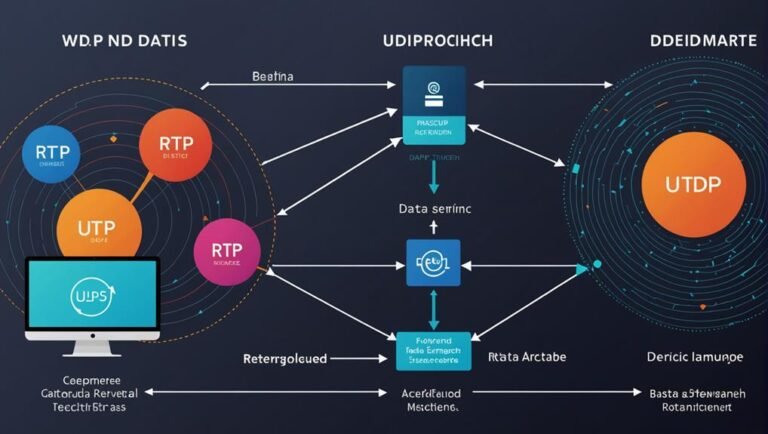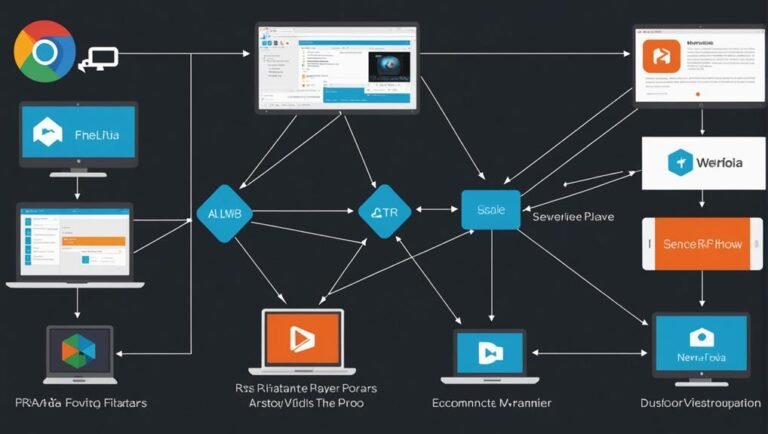When it comes to RTSP streaming, understanding unicast versus multicast is essential for your needs. Unicast means a one-to-one connection, giving you reliable bandwidth, but it can strain your network with multiple viewers. It’s great for video conferencing and applications needing dedicated streams. On the other hand, multicast shares a single stream with many viewers, saving bandwidth and enhancing scalability, perfect for live events like sports. Each method has its pros and cons, so knowing how they work can help you choose the best fit for your situation. Keep exploring to uncover deeper insights into these streaming methods.
Understanding RTSP Protocol
When it comes to streaming media, you might find yourself wondering about the role of the Real-Time Streaming Protocol (RTSP). This protocol is vital for delivering your favorite content in real-time, allowing you to control playback like play, pause, and seek. One of the standout RTSP features is its ability to handle both live and on-demand media streams, giving you the freedom to choose how you consume content.
RTSP applications are vast and varied, from video conferencing tools to Internet Protocol (IP) cameras. You’ll notice that many surveillance systems rely on RTSP to stream live video feeds, making it essential for security. In the domain of entertainment, it’s a backbone for many streaming platforms, ensuring you get a smooth viewing experience without interruptions.
Moreover, RTSP supports multiple media formats, making it a versatile choice for developers. It allows you to create applications that adapt to different devices and network conditions, which is a huge plus for anyone who values seamless access to content. By understanding RTSP, you’re not just learning about a protocol; you’re gaining insight into how media is delivered, controlled, and experienced across various platforms.
What Is Unicast Streaming?
Unicast streaming is a method where a single stream of data is sent from a server to one specific client at a time. This approach offers several advantages, such as dedicated bandwidth and a more reliable connection. Understanding these benefits can help you decide when unicast is the best option for your streaming needs.
Definition of Unicast Streaming
In simple terms, unicast streaming refers to a one-to-one communication method where a single sender transmits data to a specific receiver. This approach is commonly used in various applications, from video conferencing to online gaming, allowing you to enjoy tailored content without interference from others. With unicast, each connection is unique, meaning your experience is dedicated solely to you.
When you’re setting up unicast streaming, you’ll often deal with different streaming protocols, such as RTSP or RTP, which help manage how data is sent and received. The effectiveness of unicast can depend on your network configurations, as these settings determine how well your data streams from sender to receiver.
You might appreciate the directness of unicast since it lets you control your streaming experience, ensuring you get exactly what you want without the noise of shared connections. However, it’s essential to understand that unicast does require sufficient bandwidth and network resources to maintain a smooth experience. So, if you value a personalized streaming journey, unicast streaming could be your go-to option.
Advantages of Unicast Streaming
One of the main advantages of unicast streaming is the personalized experience it offers. When you stream content, you’re connecting directly to the server, which means you can tailor your viewing experience to your preferences. This direct connection enhances the user experience, allowing for a smoother playback without the interference of other users.
Bandwidth considerations are also in your favor. With unicast, you’re only using the bandwidth needed for your stream, avoiding the congestion that can occur with multicast. This guarantees better quality and fewer latency issues, so you can enjoy your content without annoying delays.
Moreover, unicast streaming tends to have fewer security implications. Since the data is sent directly to you, it reduces the risk of unauthorized access compared to multicast, where data is sent to multiple recipients simultaneously.
Advantages of Unicast
When you choose unicast streaming, you’re likely to see significant network efficiency benefits, especially in scenarios with fewer users. It also makes streaming management a lot simpler, as you only need to handle individual connections. This can lead to a more streamlined experience for both you and your audience.
Network Efficiency Benefits
Unicast streaming offers significant network efficiency benefits, particularly in scenarios where tailored content delivery is essential. When you choose unicast, you’re ensuring that each user receives their own dedicated stream. This means that bandwidth optimization becomes a reality, as the network can allocate resources more effectively. Instead of sending a single stream to multiple users—like in multicast—you’re only using the bandwidth necessary for each individual connection.
This approach allows you to manage your network’s resources more efficiently. You won’t have to worry about bandwidth being wasted on users who aren’t actively watching or who may not need the full quality of the stream. With unicast, you can adjust the quality of the stream based on each user’s connection capability. This flexibility not only improves the viewing experience but also enhances overall network performance.
Moreover, unicast can simplify troubleshooting. Since each stream is independent, it’s easier to identify and address issues that may arise for individual users without affecting others. Ultimately, by embracing unicast streaming, you’re making a choice that aligns with your desire for freedom in content delivery while maintaining control over bandwidth and resources.
Simplified Streaming Management
By choosing unicast streaming, you also simplify the management of your streaming services. With unicast, each viewer gets a dedicated stream, which means you can tailor your approach based on individual needs. This flexibility allows you to use various streaming protocols without worrying about network topology constraints that often complicate multicast scenarios.
You won’t have to deal with the complexities of managing multiple streams for different groups. Instead, you can focus on optimizing each user experience, ensuring that everyone enjoys seamless access to your content. The straightforward nature of unicast makes troubleshooting easier; if someone encounters an issue, you can pinpoint the problem quickly without sifting through a tangled web of shared connections.
Moreover, since each connection is independent, scaling your service becomes a breeze. You can add more users without disrupting existing streams, giving you the freedom to grow your audience effortlessly. Fundamentally, unicast empowers you to take control of your streaming services, making it a wise choice for those who value clarity and simplicity in their streaming management. Embrace this approach, and you’ll find greater ease in delivering high-quality content to your viewers.
Limitations of Unicast
While unicast streaming offers a straightforward approach to delivering media to a single recipient, it comes with considerable limitations. One major drawback is the bandwidth allocation. Every user requires a dedicated stream, which can lead to excessive resource consumption on your network. This becomes a real challenge when trying to scale, as each new client adds more strain to your connection stability.
You might also run into latency issues. With unicast, the time it takes for data to travel from the server to the client can vary widely, leading to frustrating delays. This can be particularly problematic in live events where real-time interaction is essential. Additionally, client limitations can further exacerbate these latency issues, especially if devices are not up to par.
Network security is another area of concern. Each unicast stream can create multiple entry points for potential attacks, making it harder to maintain a secure environment. You’ll need to invest more time and resources into safeguarding your streams, which can feel restrictive.
Lastly, scalability challenges are inevitable. As your audience grows, the unicast model may struggle to keep up with demand, forcing you to either limit access or greatly upgrade your infrastructure. In a world where freedom and flexibility are paramount, these limitations can feel like a tether holding you back from fully embracing the streaming experience. Understanding these challenges is essential if you want to make informed decisions about your streaming setup.
What Is Multicast Streaming?
Multicast streaming is an efficient method for delivering media content to multiple recipients simultaneously. Unlike unicast, where each user gets a separate stream, multicast allows a single stream to be sent to many users, saving bandwidth and resources. This is great if you want to share a live event, like a concert or sports match, with a large audience without overwhelming your network.
Here’s a quick overview of multicast applications and advantages:
| Multicast Applications | Multicast Advantages |
|---|---|
| Live sports broadcasting | Reduced bandwidth usage |
| Online gaming | Efficient resource allocation |
| Video conferencing | Scalability for large groups |
| IPTV services | Simultaneous delivery |
| Corporate training sessions | Cost-effective distribution |
By using multicast, you’re not just conserving bandwidth; you’re also enjoying a smoother streaming experience. It’s especially beneficial for live events where timing is essential. The ability to reach multiple users at once without needing extra infrastructure allows you to connect with your audience more freely.
In a world where we crave connection and instant access to information, multicast streaming opens up a myriad of possibilities. Whether it’s for entertainment, education, or corporate needs, understanding multicast applications can empower you to leverage this technology for your goals. Embracing multicast could be your ticket to engaging a wider audience with less hassle.
Advantages of Multicast
One of the key advantages of multicast is its ability to greatly reduce bandwidth consumption. When you’re streaming to multiple users, multicast sends a single stream of data that can be received by many, instead of duplicating the stream for each individual user. This means you can enjoy high-quality video without hogging your network’s bandwidth. For anyone who values efficiency and freedom in streaming, this is a game-changer.
With multicast, you’re looking at enhanced streaming scalability. Whether you’re hosting a live event or distributing content to a large audience, multicast allows you to scale up effortlessly. You can add more viewers without worrying about the strain on your network. This flexibility means you can focus on delivering great content rather than managing bandwidth limitations.
Moreover, multicast enables bandwidth optimization. Instead of every viewer pulling their own copy of the stream, the network efficiently delivers one stream to multiple users. This not only conserves bandwidth but also reduces the load on your servers. You get to stream high-quality content smoothly, which is essential for keeping your audience engaged.
In a world where digital freedom is paramount, multicast offers a way to enjoy seamless, high-quality streaming without the usual constraints of bandwidth. By embracing this technology, you’re empowering yourself and your audience to experience content like never before, without unnecessary interruptions or limitations.
Limitations of Multicast
Some might overlook the limitations of multicast, but they can greatly impact your streaming experience. While it offers benefits, there are significant multicast challenges you need to evaluate. For starters, bandwidth issues can arise when multiple users attempt to access the same stream simultaneously. This might lead to buffering or degraded quality, which could ruin your viewing experience.
Network complexity is another hurdle. Setting up a multicast network often involves intricate configurations, requiring specialized knowledge that can complicate things. If you’re not familiar with these systems, you may find yourself facing unexpected difficulties that could limit your streaming freedom.
Then there are scalability concerns. As your audience grows, managing multicast streams effectively can become intimidating. The more users you have, the more strain it puts on your network, and without proper management, you could face significant performance drops.
Compatibility limitations also play a role. Not all devices or networks support multicast, which can restrict your audience. If your potential viewers can’t access your stream, you’re limiting your reach and, ultimately, your impact.
Finally, implementation hurdles can be a real obstacle. Setting up multicast requires careful planning and sometimes a hefty investment in infrastructure. If you’re looking for a hassle-free solution, these challenges might steer you towards unicast options instead.
In essence, while multicast offers unique advantages, it’s essential to weigh these limitations against your streaming goals.
Use Cases for Unicast
When it comes to streaming, unicast is often the go-to solution for various scenarios. It provides a direct and reliable connection between a single sender and a receiver, making it perfect for applications where you want to guarantee a high-quality experience without interruptions. For instance, during a live event, unicast can deliver a seamless stream to each viewer, making sure everyone enjoys the action without lag.
In the area of security, unicast is invaluable for monitoring security cameras. Each camera can send its feed directly to the monitoring station, allowing for real-time surveillance without any interference from other streams. Similarly, in video conferencing, unicast allows participants to communicate effectively, guaranteeing clarity and minimal delay.
When it comes to remote education, unicast is essential for delivering lessons to students. This method makes certain that each learner receives the same content simultaneously, providing an engaging and interactive experience. Corporate training sessions can also benefit from unicast, allowing employees to participate in live training without worrying about bandwidth limitations.
Home entertainment is another area where unicast shines. Whether you’re streaming movies or playing games online, a unicast connection guarantees a smooth experience without buffering. Finally, for digital signage, unicast allows you to update content easily and directly to each screen without confusion or mix-ups.
In all these scenarios, unicast provides the freedom and reliability needed for a high-quality streaming experience.
Use Cases for Multicast
Multicast excels in scenarios where multiple users need to receive the same content simultaneously, making it ideal for applications like live sports broadcasts or corporate webinars. By leveraging multicast technology, you can efficiently distribute high-quality streams without overloading your network. This is especially important when you want to reach a large audience without sacrificing performance.
Here are some key multicast applications you might consider:
- Live Sports Events: Imagine broadcasting a thrilling game to thousands of fans simultaneously. With multicast, you guarantee everyone gets the same experience without straining your bandwidth.
- Corporate Training Sessions: If you’re conducting a webinar for your team or clients, multicast allows you to share presentations and videos seamlessly. Participants can engage in real-time, fostering a collaborative environment.
- Emergency Alerts: In crisis situations, it’s vital to disseminate information quickly. Multicast enables governments and organizations to send alerts to multiple users at once, guaranteeing that everyone stays informed.
The multicast benefits go beyond just efficient bandwidth usage. It’s about creating a more inclusive experience, where everyone can participate and share in the moment. With the freedom to connect with a vast audience, multicast technology empowers you to reach your goals without the hassles of traditional unicast methods. Embracing multicast can transform how you engage with your viewers, making it a powerful tool in today’s digital landscape.
Frequently Asked Questions
How Do Firewalls Affect RTSP Unicast and Multicast Streaming?
Firewalls can greatly impact your streaming experience. Depending on their configurations, they might block or allow specific network protocols used in streaming. If you’re focused on streaming security, you’ll want to guarantee your firewall permits the necessary ports. Additionally, improper settings can lead to bandwidth management issues, affecting your stream quality. So, it’s essential to balance security with accessibility to enjoy seamless streaming without interruptions or slowdowns.
Can RTSP Support Both Unicast and Multicast Simultaneously?
You can’t have your cake and eat it too, but with RTSP, you can have both unicast and multicast streams! By adjusting the RTSP configuration options, you can enable simultaneous streaming modes. This flexibility allows for a streaming performance comparison, ensuring you reach diverse audiences while optimizing bandwidth. Embrace the freedom of choice in your streaming strategy, and enjoy the benefits of both methods without compromising quality or accessibility.
What Devices Typically Support RTSP Streaming?
When you’re looking at devices that support RTSP streaming, you’ll find a variety of options. Most IP cameras, network video recorders, and media players are RTSP devices, offering great streaming compatibility. Smartphones and smart TVs also often come equipped with RTSP capabilities. This flexibility lets you enjoy your content freely, allowing you to connect and stream seamlessly across different devices. Just make sure your device supports RTSP to get started!
Is RTSP Compatible With Other Streaming Protocols?
Yes, RTSP can be compatible with various other streaming protocols, allowing you to integrate it into your existing systems. Many RTSP applications support protocols like RTP and RTMP, enhancing versatility. When you’re considering RTSP, don’t overlook RTSP security features, which can help protect your streams. This compatibility gives you the freedom to choose the best combination for your needs, ensuring a seamless streaming experience across different platforms and devices.
How Does Latency Differ Between Unicast and Multicast?
Latency can really vary depending on how you’re streaming. Did you know that unicast can add up to 30% more latency than multicast? This often leads to buffering issues, especially during peak times. With unicast, every connection is separate, which can create network congestion. Multicast, on the other hand, sends data to multiple users simultaneously, reducing that congestion and keeping your experience smoother. So, if you crave freedom in streaming, multicast might be the way to go!



